Brian Branciforte, Florida's Wildlife Legacy Initiative Leader
In addition to habitat loss and fragmentation, disease and invasive species, another threat to conservation often makes its way into the discussion -- funding. While funding and capacity are not traditional threats to wildlife, they have been a constant issue for most conservation-oriented organizations.
In 1994, the Teaming with Wildlife coalition and campaign was initiated to bring legislative awareness and action toward securing long-term, dedicated and sustained fish and wildlife funding nationwide. Over the last 23 years, the coalition has grown to over 6,400 organizations representing millions of conservationists. Teaming with Wildlife was instrumental in establishing the State and Tribal Wildlife Grants program in 2000, which has invested over $1 billion in state-based fish and wildlife conservation, and it led to the development and implementation of State Wildlife Action Plans that aim to conserve over 12,000 species of greatest conservation need across the county.
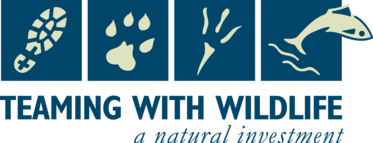
Left: The Teaming With Wildlife Logo. After 23 years, the Teaming With Wildlife brand will be transitioned to a new campaign
While we celebrate the success of the Teaming with Wildlife movement and the State Wildlife Grants program, they are milestones on the way to a larger goal. That’s why in 2014 the Blue Ribbon Panel on Sustaining America’s Diverse Fish and Wildlife Resources was formed and subsequently released its recommendation to secure $1.3 billion annually for fish and wildlife conservation. Following through on the recommendation, the Recovering America's Wildlife Act was introduced in the U.S. Congress in 2016.
In the current U.S. congressional session, conservation leaders are preparing for another stage of legislative effort. The Teaming with Wildlife brand, messaging, and approach will be transitioned to a new phase consistent with a new day, new energy and new hopes of securing broader, dedicated conservation funding nationwide.
While we stand down and move on from Teaming with Wildlife, rest assured nothing has changed in terms of the ultimate goal of attaining fish and wildlife funding. We hope you continue to engage in and support this effort, and we will keep you informed of its progress. Teaming with Wildlife is in our DNA -- the visionary campaign achieved a lot for wildlife funding and conservation, for which we can be collectively grateful. Now we are embarking on an exciting and ambitious new campaign path with similar vigor.
|
Back to top
Sarah Duncan, Wildlife Ecology and Conservation Post-Doctoral Associate, University of Florida
The southeastern pocket gopher (SEPG; Geomys pinetis) is
vital to the proper functioning of natural pinelands in the southeastern U.S. SEPGs are small, fossorial (i.e., adapted to digging and living
underground) rodents known for being ecosystem engineers. They promote
diversity in the ecosystem by aerating and recycling nutrients in the soil
through their burrowing activity, increasing plant diversity because of their burrowing
and foraging and also providing shelter for other species that live in their
extensive tunnel systems.
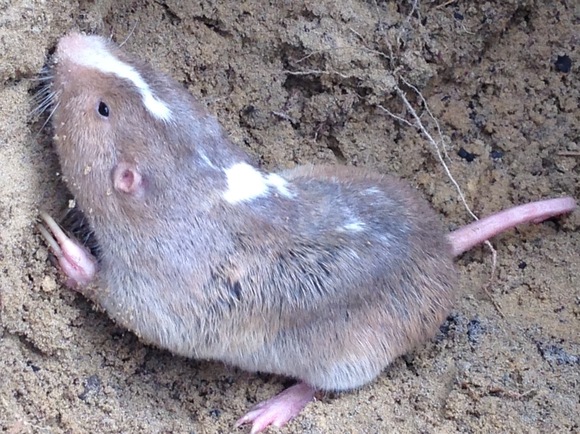 Above: A female southeastern pocket gopher from Florida,
Photo courtesy of Sarah Duncan, University of Florida
Given
the important ecological role of the SEPGs in the natural pineland system, it
is essential to learn more about the ecology, natural history, distribution and
population dynamics of the southeastern pocket gopher. Additionally, SEPGs have
been identified as a Species of Greatest Conservation Need in all three states
in which they are found (Florida, Alabama, and Georgia) and are listed as
threatened in Georgia. Therefore, there is a need to acquire information and
develop tools necessary to properly assess and monitor SEPG populations. In order
to address these information needs, biologists from the University of Florida, FWC,
and collaborators across the SEPG’s range applied for and received a U.S. Fish and Wildlife Service Competitive
State Wildlife Grant to gather information on the distribution and abundance of
the species, and to identify key habitats essential to the conservation of the
species.
The goals of the project include providing specific management recommendations for restoring and maintaining important SEPG habitat conditions, maintaining connectivity among populations, and reintroducing SEPGs into appropriate habitat. To do this, researchers are conducting statewide surveys for SEPG presence and absence across their native range to identify factors that limit the distribution and abundance of SEPGs. Researchers also are collecting genetic samples from SEPGs to conduct range-wide analyses to understand population structure and connectivity in this understudied species.
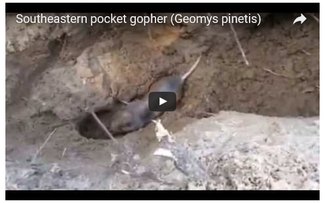 Watch a video of the southeastern pocket gopher excavate a tunnel on the University of Florida's pocket gopher project Web page.
To help with identifying areas inhabited by pocket gophers, an iNaturalist Project has been established where both professionals and citizens can help identify areas where southeastern pocket gophers are present. Local identifications will be part of the large-scale surveying efforts across the three southeastern states.
Additionally, researchers are looking for SEPG populations in order to collect genetic samples. If you have information on the presence of SEPG populations or questions about the SEPG project, contact Sarah Duncan.
|
Back to Top
Allie McCue, Florida's State Wildlife Action Plan Coordinator
Developing or revising planning documents is never an easy
task, and more times than not takes longer than expected. This spring marks the
two-year anniversary of when the Florida Wildlife Legacy Initiative began working
on the second revision of the State Wildlife Action Plan. With a couple of years
under our belt and substantial progress made, we are holding tight to our self-imposed
deadline of completion by December 2017. That being said, the next nine months will be quite
busy as we take our draft chapters and sections through the review process and
one step closer to finalization.
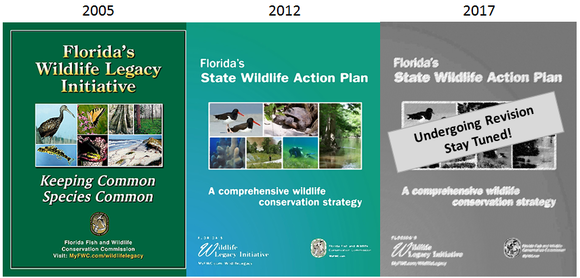 Above: Cover pages of the 2005 and 2012 State Wildlife Action Plans. The second revision of the Action Plan will be released in 2017.
The Species of Greatest Conservation Need (SGCN) list was the first component of the revision to complete the review process. After being reviewed internally at the FWC, the revised list and criteria were distributed externally and open for a one-month period of comment. During this time, a webinar was held to answer questions and gather additional feedback. Changes were made based on the input received, and the SGCN criteria and list now are almost finalized. The list will be available for review again prior to completion of the revised Action Plan.
Other chapters and sections of the revised Action Plan will be directed through a similar review process to allow ample time for comments and suggestions from internal and external partners. The next item open for review will be the new Ecosystem Chapter, previously known as the Habitat Chapter in the 2012 Action Plan. The Ecosystem Chapter is comprised of ecosystem descriptions, their significance, major threats, priority actions and associated species lists. The draft chapter is scheduled for review late this spring.
If you would like to be included on the Action Plan Revision distribution list, and receive information first hand regarding review periods, please send an email to Allie.McCue@MyFWC.com, previously Alexandra.Perryman@MyFWC.com.
Back to Top
Arlo Kane, Northwest Regional Coordinator, Office of Conservation Planning Services
Thomas Kuhn, Northwest Region Wildlife Legacy Biologist
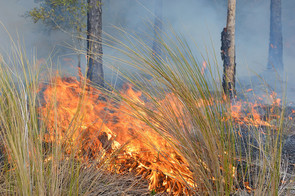 Historically, natural fires have been a key element in the creation and maintenance of the habitats which support Florida’s wildlife. However due to increasing human population and altered natural communities, it is unsafe to allow most lightning-ignited fires to burn uncontrolled. This means Florida must rely heavily on prescribed fire (pictured right: a prescribed fire conducted on Andrews Wildlife Management Area) as a key tool for wildlife and habitat management. State and federal agencies do not have the capacity to take on this task alone, and so the conservation community is working with partners to develop alternative, cost-effective ways to increase the number of acres burned annually. One example is the development of fire strike teams, an effort funded in part by State Wildlife Grants. With the help of SWGs, these teams have been successful at burning 462,500 acres since 2004. Fire strike teams are primarily focused on burning public lands and lands owned by conservation-based organizations. But what about privately owned lands? Wildlife do not strictly utilize public lands and also rely on private lands that may not be routinely burned.
The growing demand for prescribed burning assistance on private lands is much greater than the Florida Forest Service can help provide. Landowners may be on a waiting list for years before their land is burned, and in the meantime the habitat may become overgrown and its value to Species of Greatest Conservation Need, including gopher tortoises, southeast American kestrels and gopher frogs, and popular game species such as Northern bobwhite quail, will decline. Other options such as hiring a private consultant to conduct a burn can be cost-prohibitive for many landowners. While most landowners understand the need for prescribed fire, they often cannot burn as frequently as necessary or conduct burns in the summer months when most fires historically occurred. Private landowners also often do not have the necessary equipment, training or assistance to burn their land.
The FWC’s Landowner Assistance Program (LAP) is attempting to meet these challenges by encouraging landowners to join together and help each other conduct safe inexpensive burns through the development of Prescribed Burn Associations. The PBAs are member-led groups of landowners who provide assistance to one another and help conduct prescribed burns on each other’s land. By using PBAs, states such as Texas, Oklahoma, Illinois, Kansas and Nebraska have been very successful at increasing both the number of trained prescribed burners and the number of acres burned on private land.
|
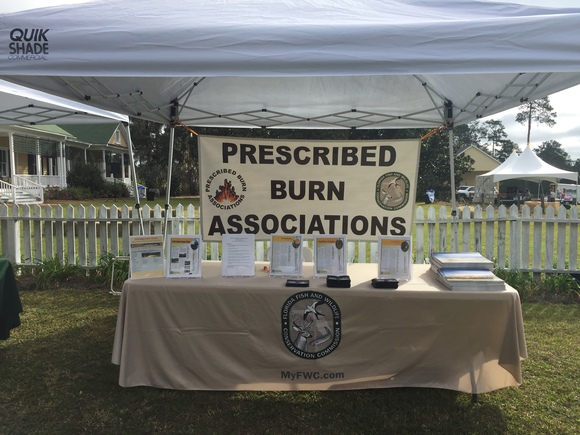
Above: Prescribed Fire Association booth at a fire festival at Tall Timbers Research Station & Land Conservancy, FWC photo by Arlo Kane
LAP biologists have held several workshops around the state
to educate landowners about the benefits of establishing Prescribed Burn
Associations. A number of interested landowners who attended these workshops
have already sparked the development of PBAs in Okaloosa/Santa Rosa,
Gadsden/Wakulla and Alachua/Marion/Putnam counties. The FWC has partnered with
the Prescribed Fire Training Center at Tall Timbers Research Station to provide
at least one PBA with a two-day training session. This session consists of one
day in the classroom and one day burning a PBA member’s property as a group.
The group will help plan the burn and walk through the entire process that goes
into conducting a burn together.
Landowner participation and leadership of PBAs is crucial to
their success. The FWC hopes providing proper training and support during the
development of each PBA will give the groups the confidence and knowledge to eventually
conduct prescribed burns on their own.
For more information on this effort or to get involved,
please contact Arlo.Kane@MyFWC.com
For more information about the Terrestrial Goal or the Fire
Strike Teams supported by State Wildlife Grant funding, please contact Heather.Hitt@MyFWC.com
Back to Top
The Florida Fish and Wildlife
Commission has proposed modifying the agency’s Grant Rule (68-1.003) to include
revisions
and reformatting to Florida’s State Wildlife Grants Program Guidelines, Budget
Forms and Application Form. These revisions would remove obsolete language and
references, provide updated language and references, clarify differences
between and procedures of Florida’s State Wildlife Grants Program and U.S. Fish
and Wildlife Service’s Competitive State Wildlife Grants Program, and include
new requirements for complete proposals to address changes in 2 CFR 200 and the
Federal Grants Tracking System.
The Notice of Development of Rulemaking was
published on November 22, 2016. Stakeholders and partners that have shown
interest in Florida’s State Wildlife Grants Program were emailed with a summary
of the proposed changes on November 29, 2016. The Program received one request
for additional information on the proposed revisions. No significant concerns
with the proposed revisions have been brought to the Program’s attention. FWC
published the associated Notice of Proposed Rulemaking on February 9, 2017.
If you have any questions regarding the proposed rule updates, or
wish to view the revised Guidelines or forms, please contact Florida's State Wildlife Grants Coordinator, Andrea Alden, at 850-617-9558
or Andrea.Alden@MyFWC.com.
Back to Top
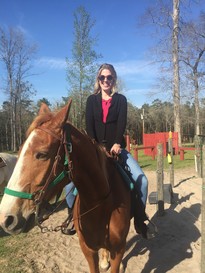 Lily Swanbrow Becker (pictured left) is the new Climate Adaptation Coordinator, based
in Tallahassee. She graduated from the
University of Michigan with a degree in Environmental Science in 2005 and
received her Masters in Conservation Biology from Texas State University in
2012. Her graduate work primarily
focused on endangered freshwater fish and amphibians. Prior to joining FWC, Lily worked in
curriculum development at Florida State University where she developed
educational texts, lesson plans and interactive tutorials focused on topics
covering conservation biology, ecology, and climate change. Lily is passionate about supporting FWC’s
climate adaptation efforts and is excited to work with staff across the agency
in this capacity. Her role in Florida's Wildlife Legacy
Initiative includes leading the implementation of the Climate Adaptation
Goal, which focuses on supporting research, planning, and on-the-ground climate
adaptation projects. In her spare time,
Lily mostly chases around two toddlers but also enjoys running and beach
days. Please stop by and say hello or
reach out by email (Lily.SwanbrowBecker@MyFWC.com) any time!
|
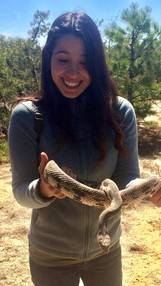 Yasmin Serajfar (pictured right)
is the new Wildlife Legacy Biologist for FWC's North Central Region, located in
the Lake City regional office. She received her Masters in Environmental Science from
Drexel University in 2015, and started working for FWC’s Wildlife Assistance
Program upon her graduation. She has spent time studying a variety of species,
but has primarily focused on North American and African reptiles. She also has
a passion for marine conservation and co-founded an organization in early 2015
that focuses on education and outreach for marine conservation issues and
projects. Her role as part of Florida's Wildlife Legacy Initiative is leading the
implementation of the Data Gaps Goal, which focuses on filling knowledge
gaps for Species of Greatest
Conservation Need. In her spare time, Yasmin enjoys scuba diving and
photography. If you are in the North Central Regional Office, please stop by
and say hi!
Please contact us is you have questions about the FWLI program or the goals.
|
Back to Top
After completing the State Wildlife Action Plan in 2005,
the Florida Fish and Wildlife Conservation Commission (FWC) worked with
partners to set goals for implementing the Action Plan at five-year intervals. Under
the self-imposed five-year Action Plan revision schedule, the idea was to
develop a new set of implementation goals reflective of the priorities
identified in each corresponding Action Plan revision. These goals help direct
the use of FWC resources including State Wildlife Grant
funding. Ideally they also guide conservation efforts outside
the realm of SWG, providing opportunities for partners to work together and
help leverage resources to conserve Florida's fish and wildlife.
From 2006 to 2011, the FWC and partners made significant
progress on implementing the 2005 Action Plan goals (see Florida’s First Five Years of Action Plan Implementation). In
2011, the FWC reconvened partners to collaboratively develop revised
implementation goals for 2012-2017 that aligned with the first revision of
the Action Plan, approved by the U.S. Fish & Wildlife Service in 2012.
By updating the goals regularly, the FWC can engage in
new priorities and work with partners in new ways to improve fish and wildlife
communities and their habitats. Revised goals also help the FWC focus limited
resources in areas of most need, identified by each Action Plan revision. The
2012-2017 goals have now been extended through July 2018. The additional
year was added to align with the release of the second revision of the Action
Plan (see above article, "Action Plan Revision: It's a marathon, not a sprint!").
The ultimate goal of the Florida Wildlife Legacy Initiative Program
and Action Plan is to conserve Florida’s native wildlife and habitats
through non-regulatory, voluntary, incentive-based actions and partnerships.
Partnerships are critical to successful implementation of the Action Plan
because this effort is much larger than any one agency or organization can
accomplish alone. We encourage your participation in implementing these goals
and look forward to working with you.
Please visit FWLI’s Goals: Taking Action Web page to view the goals and
objectives.
Back to Top
We don't always take enough time to celebrate hard work and amazing
accomplishments. Florida’s Wildlife Legacy Initiative is recognizing the
following principal investigators who finished their State Wildlife
Grant-funded projects since the last newsletter publication. These projects demonstrate the
wide variety of conservation efforts taking place in Florida – from research
and on-the-ground restoration to management, mapping and monitoring. For more
information on the following projects, please contact Andrea.Alden@MyFWC.com or Robyn.McDole@MyFWC.com.
Congratulations to all on work well done!
------------------------------------------------------------
Correction: In the FWLI Summer 2016 Newsletter, the incorrect university was listed for the following living shorelines project. We apologize for this error and have reprinted the highlight here.
Living Shorelines: Engaging Communities While Stabilizing Historic
Sites - Linda Walters & Melinda Donnelly, University of Central Florida
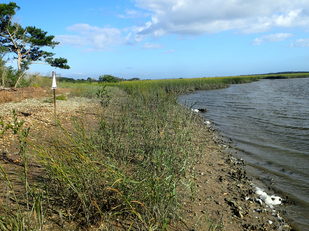 Funded through the Climate Adaptation Objective, the goal of this project was to
create living shorelines at two historically significant
coastal shell middens (a small hill or mound made up almost entirely of mollusk
shells discarded by Native Americans) at Seminole Rest in Canaveral National Seashore and Fort Mose Historic State Park.
Right: The shell midden at Fort Mose Historic State Park was
stabilized with a combination of oyster shell bags and mats, saltmarsh cordgrass transplants, and black mangrove
seedlings, Photo courtesy of the University of Central Florida.
Resource managers are interested in alternatives to hard-armoring shorelines that
will provide both protection from erosion and quality habitat for diverse
assemblages of estuarine species now and into the future. Living shoreline
restoration/stabilization to mimic local, natural shoreline communities is one
such alternative. Through pre- and post-project monitoring, the stabilizations
were found to be highly effective, and the project was one of the first studies
to document a variation in biodiversity between hard-armored shorelines,
natural shorelines and shorelines stabilized using living shoreline
methodology. Students and volunteers from the local community were heavily
involved in the construction of both living shorelines. The project also developed
three fact sheets on the importance of living shorelines to engage youth and
adult audiences.
------------------------------------------------------------
|
1. Evaluating the role of the predatory snail, Thais deltoidea, on enhancing survival of out-planted staghorn corals as part of a comprehensive coral reef restoration strategy – Gabe Delgado, Florida Fish and Wildlife Conservation Commission
 Funded through the Marine Goal, the goal of this project was to examine the relationship between the carnivorous snail Thais deltoidea and the corallivorous snail Coralliophila abbreviata. C. abbreviata has been shown to be a primary source of chronic mortality of wild populations and nursery-propagated colonies of Staghorn and Elkhorn coral. This project sought to understand the predator/prey dynamics among these species in the hopes that they could ultimately aid in minimizing the effects of predation upon newly restocked coral colonies by corallivorus snails.
Left: The corallivorous snail, Coralliophila abbreviata, consuming a fragment of staghorn coral used in a manipulative aquarium experiment, FWC Photo by Gabe Delgado
Laboratory experiments showed that T. deltoidea readily preys upon C. abbreviata, although, it is not a preferred prey item. Nevertheless, in experiments with T. deltoidea, higher percentages of live coral tissue remained than in the treatment where T. deltoidea was absent. This occurred not only because of the consumption of the C. abbreviata, but also by reducing the time spent by the C. abbreviata on the corals (i.e. avoiding the T. deltoidea as it foraged in the aquarium). If this trophic relationship proves to be ecologically relevant in situ, using this predator-prey dynamic will allow coral reef restoration practitioners in Florida to develop a restoration strategy that entails out-planting corals in areas of high T. deltoidea density and/or translocating T. deltoidea to coral out-plant sites to mitigate the effects of the corallivores and enhance coral survival.
|
2. Development of a Health Protocol for
Hatchery-Reared Long-Spined Sea Urchins, Diadema
antillarum – Ruth Francis-Floyd, University of Florida
Funded through the Marine
Goal, the goal of this project was to develop health assessment techniques and criteria
that minimize the risk of unintentional pathogen release when hatchery-reared
urchins are out-planted. Under this grant, the research team developed
appropriate diagnostic health testing protocols for the species. “Health
Evaluation Forms” and descriptions of “Field Protocols for Diadema Diagnostic
Testing” were developed, tested, revised and finalized. Nearly 200 wild sea
urchins from the Florida Keys were examined to determine size, weight,
appearance, behavior, coelomic fluid, and normal histology of healthy D. antillarum. The Diagnostic Manual for
D. antillarum had been completed and is available upon request and
through the University of Florida.
3. Identification of suitable coral
restoration sites and resilient coral reef communities through assessment of
existing coral monitoring data – Luke McEachron, Florida Fish and Wildlife Conservation
Commission
Funded through the Marine
Goal, the goal of this project was to identify coral restoration sites and resilient
coral communities through a spatial conservation prioritization model
framework. Project personnel held two stakeholder workshops to guide model
development, define resiliency and restoration techniques, accumulate data, and
define model validation. Two statistical models were created to prioritize Acropora cervicornis restoration site selection and general coral
cover protection at a 1 square kilometer spatial resolution. The A. cervicornis trend model identified locations where A. cervicornis was predicted to be Never Present, Transiently
Present, or Continuously Present with over 98 percent of the training data
correctly classified. The coral cover categorical model identified locations
where coral cover was predicted to be High, Medium, or Low with over 81 percent
of the training data correctly classified. Notably, coral cover and Acropora cervicornis trends are driven by a different combination of
environmental factors. Project personnel completed additional independent model
validation field surveys in September 2016 that provided strong support for the
developed models. Project personnel combined models in Zonation to create six
prioritization scenarios; the scenarios were subsequently distributed to
stakeholders via a third workshop and a web mapping application.
4. Monitoring and Mapping of Dendrogyra cylindrus Corals of the Florida Reef Tract – Kate Lunz, Florida Fish and Wildlife Conservation Commission
Funded through the Marine
Goal, the goals of this project were to, 1)
better estimate current population size of D. cylindrus corals, 2)
establish a demographic monitoring program of D. cylindrus within Palm
Beach County, Broward County, the Florida Keys National Marine Sanctuary, and
the Dry Tortugas National Park, 3) document spawning during the full moon in
August of 2013, 2014, and 2015, and 4) collect and integrate D. cylindrus corals
of opportunity (COOs) of known genotypes into regional coral nurseries. This
work was completed over the course of three years. Information gained from this
project will improve the success potential for Florida’s Imperiled Species
Management Plan and a Federal Management Plan for species conservation.
Conducting a census of this coral’s population status and trends, sex ratios
and exploring sexual reproduction potential has filled crucial data gaps on the
current population status, and will facilitate successful restoration efforts
to be catered specifically to the species’ biology, reproductive capacity,
ecological habitat requirements and historical range.
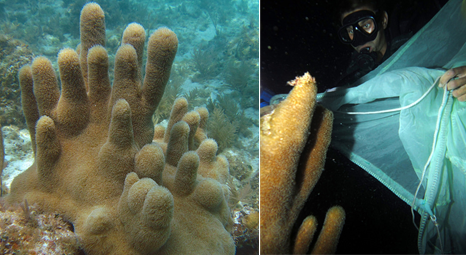 |
Left: Pillar Coral (D. cylindrus), FWC Photo. Right: Researcher places a gamete collection bag over a pillar coral colony during a spawning event, FWC Photo.
5. Addressing data gaps for the Everglades mink and Sherman’s short tailed shrew – Chris Winchester and
Jeff Gore, Florida Fish and Wildlife
Conservation Commission
Funded through the Data
Gaps Goal, the goal of this project was to fill gaps in
knowledge for the state-listed
Threatened Everglades mink (Neovison
vison evergladensis) and the Sherman’s short-tailed shrew (SSTS; Blarina shermani).
Both the Everglades mink and SSTS were at a zero knowledge level with critical
information on taxonomy and distribution lacking for both. In order to address data
gaps for Everglades mink and SSTS, project personnel initiated research aimed
at addressing three objectives: 1) Sample at least 30 locations to determine
the distribution of Everglades mink within the presumed range in south Florida.
2) Develop and monitor 10 long-term and 30 short-term trapping arrays to
determine if the Sherman’s short- tailed shrew is still extant within the
identified range. 3) Evaluate the taxonomy of the Everglades mink and SSTS by
collecting DNA samples from mink using hair snares or by live trapping. Between
August 2014 and December 2016, project personnel surveyed 61 locations on three
conservation areas for Everglades mink using camera traps, visual surveys and
track plates. Project personnel detected Everglades mink at two locations with
camera traps and one location with visual surveys, all in Fakahatchee Strand
Preserve State Park. Overall survey methods were unsuccessful, and mink
detections were too few to estimate range. For SSTS, project personnel
monitored 63 short-term and 17 long-term drift fence arrays between December
2014 and August 2016 for a total of 1,380 trap days, capturing 2 Blarina specimens. Survey results
confirm the presence of Blarina
within the presumed range of SSTS, however project personnel could not perform
genetic analysis to confirm the presence of SSTS with only two specimens.
Project personnel performed genetic analysis on Everglades mink specimens and
made comparisons to samples collected from two additional subspecies of mink.
The results of genetic analysis suggest Everglades mink is a distinct
subspecies and displays a lack of genetic diversity that could indicate a small
population size.
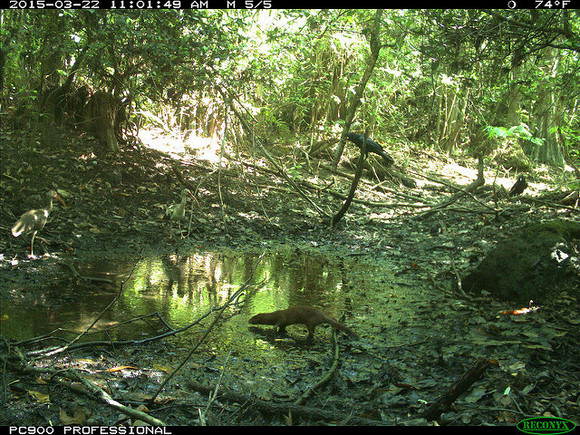
Above: A camera trap captures a picture of an Everglades mink, FWC Photo.
6. Filling in Data Gaps for Obligate Invertebrate Commensals of the
Gopher Tortoise – Gary Knight and David Almquist, Florida Natural
Areas Inventory, Florida State University
Funded through the Data
Gaps Goal, the goal of this project was to gather
distribution data for 13 obligate invertebrate commensals (OIC) of gopher
tortoises, determine their habitat associations and create habitat suitability
models for OIC species. One additional species that is not an OIC was also
surveyed. Ten of these species are Species of Greatest Conservation Need
identified in Florida's State Wildlife Action Plan. Project
personnel surveyed for gopher tortoise OICs using various methods in multiple
regions of Florida, consisting of various habitat types. More than 1,000
samples were taken from traps and burrows, with 141 samples being positive for
OIC. Ten of the 14 target species were identified during sampling. Three of the
more common and widespread species were found in the majority of regions
surveyed. Four were documented from pine plantation, abandoned field, sandhill,
upland mixed woodland and upland pine habitats. OIC were not documented in
mesic or scrubby flatwoods. It appears that most OIC do not require pristine
habitats, but rather xeric areas with healthy tortoise populations. At least
two species, the Gopher Tortoise Copris Beetle and Gopher Tortoise Noctuid
Moth, appear to have declined. Research is highly recommended on them and other
of the rarer OIC species. Habitat models completed as part of this project
identify suitable habitat for OICs and will greatly facilitate future research
on these species. This project helped address the Data
Gaps Goal by moving the 10 SGCN up at least one knowledge level.
7. Molecular Phylogeny, Species
Distributions and Habitat Characteristics of the Highly Endemic Silt Snail Genus
Floridobia – Alicia Slater, Stetson University
Funded through the Data Gaps Goal, the goal of this project was to fill data gaps of freshwater snails of the Genus Floridobia (Gastropoda: Hydrobiidae). These snails are critical functional components of many Florida spring systems and exhibit a high degree of endemism in Florida. Prior to this study, there were no quantitative data regarding current population status or trends of abundance of Florida Floridobia populations and there had been no molecular research to demonstrate phylogenetic relationships or estimate historical and contemporary patterns of gene flow among populations. Floridobia populations were sampled from nine spring systems, using habitat-specific quantitative methods to determine habitat preference, abundance and population viability, and also to establish a baseline for future comparisons. Floridobia specimens were collected from the same nine spring systems and processed for genetic analyses. Results indicate nine of the 11 Florida-endemic Floridobia species are still present in their respective springs, however project personnel were unable to verify the status of one (F. vanhyningi) due to restricted access to the spring. One species, Floridobia leptospira, is now thought to be extinct, and another, previously thought to be extinct (Floridobia monroensis), was collected during the course of this project and included in the molecular phylogeny. Transcriptome sequencing revealed very low genetic variation at mitochondrial and nuclear loci in all species surveyed. The resulting phylogenetic tree has very low support and does not support the monophyly of the species. A taxonomic revision using total evidence (molecular and anatomical data) is indicated.
 |
Above: Photographs of six silt snails of the genus Floridobia known to occur in Florida, Photo courtesy of Dr. Jason Bond, Auburn University, Co-Principal Investigator of this project
8. Genetic Assessment of Gopher Frog Populations in Florida – Kevin Enge, Florida Fish and Wildlife Conservation Commission
 Funded through the Data
Gaps Goal, the goal of this project was to understand
gene flow and genetic diversity of the gopher frog, Rana (=Lithobates) capito (pictured left, FWC Photo). This is necessary to determine
whether populations will remain viable over time in Florida and whether
additional management actions are needed in cases where populations have become
isolated due to manmade barriers. The first objective of this study was to
determine the amount of gene flow and degree of genetic variation among
populations in 15 different geographical locations of known or suspected
occupancy (areas of occupancy or AOs) that may be genetically isolated by
natural or manmade barriers. Project personnel collected a total of 1,748
samples from 127 ponds in 14 of the 15 primary AOs and all five alternate AOs.
The second objective was to examine rates of gene flow and genetic variation
among breeding ponds within the same AO by collecting ≥30 genetic samples from at
least four ponds in 3 AOs. A total of
1,191 samples from 64 ponds on 27 properties were genotyped across 10 microsatellite loci.
Genetic diversity remains high within Florida
populations, but relatively little recent gene flow occurs among populations.
Gopher frogs have been known to disperse at least 5 km, but even relatively
small streams and narrow areas of unsuitable habitat apparently pose barriers
to movement. Population clustering analyses identified Florida’s Panhandle and
peninsular populations as two genetic clusters separated by the low-lying
region near the Aucilla River. The Panhandle
and peninsular genetic clusters correspond with the Coastal Plain and
peninsular lineages identified previously using mitochondrial DNA, but project
personnel failed to detect a genetic break in the peninsula. This and an earlier genetic study suggest
that the Panhandle and peninsular subpopulations should be considered different
management units.
|
9. Response of ecosystem function in mangrove forests to sea level rise and climate change – Ryan Moyer, Florida Fish and Wildlife Conservation Commission
Funded through the Climate Adaptation Objective, the goal of this project was to examine regional sea level history and impacts on production and burial of organic carbon at a variety of locations along the natural range of mangrove habitats on Florida’s west coast between Monroe and Pinellas Counties. A total of five locations were selected for this study, including: Tampa Bay (Hillsborough/Manatee Counties), Charlotte Harbor (Charlotte County), the Ten Thousand Islands (Collier County) the Lower Florida Keys and the Marquesas Islands (Monroe County); and Biscayne Bay (Miami-Dade County). Map-based analyses of historical distributions of mangrove habitats within each of these regions was also conducted. A geological reconstruction of sea level over the past 2,400 years was combined with an assessment of regional tide gauge data. Sea level in the region fell between 300 BCE (before the common era) and 100 BCE, and then did not deviate significantly from zero until ~1500 CE (common era) when the rate of sea level rise started to accelerate until a 100-year rate of 2.02 mm/yr was achieved in 2014 CE.
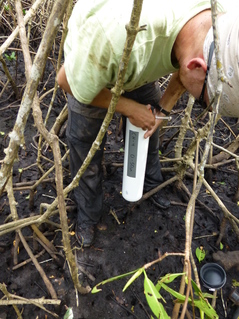 Left: Researcher Josh Bretihaupt takes a core sample in the Charlotte Harbor mangroves, FWC Photo.
Analysis of the organic carbon within mangrove peats of southwest Florida revealed that mangrove productivity and organic matter deposition was the dominant driver of accretion rates in the mangroves across this region. Overall, ecosystem productivity was found to be sufficient enough that peat accretion in mangrove habitats of southwest Florida are maintaining pace with present rates of regional sea level rise. However, under the fastest projected rates of sea level rise over the next few decades (~12.2 mm/yr), submergence of mangrove habitats is expected in less than 75 years across southwestern Florida. Project personnel determined five management recommendations to facilitate proactive decision making towards increasing resiliency and preservation of Florida’s mangrove habitats.
10. Impacts of Shifting Environments on Freshwater Streams in the Florida Panhandle – Mark Barrett, Florida Fish and Wildlife Conservation Commission
Funded through the Climate Adaptation Objective, the goal of this project was to examine streams in the Florida Panhandle to determine how stream conditions might be altered under climate change and how this might impact imperiled aquatic species, specifically fish and mussels. Understanding how and where these impacts will affect the streams in the Florida Panhandle may assist in protecting key habitats for future aquatic populations. These conditions were modeled using Maxent software (maximum entropy algorithm), based on species occurrences and known habitat conditions, and those conditions projected to the middle and the end of the century. Project personnel used stream modeling software (ArcSWAT) and two climate change models that provided input for Maxent to estimate future stream conditions, and then related those conditions to the habitats in which imperiled species have been found. Project personnel were able to model 42 species (24 fish species and 18 mussel species). Modeled responses and which variables drove the models varied substantially (e.g., average streamflow tended to be a factor for mussel distributions and temperature tended to affect fish distributions) for both fish and mussel species, demonstrating increases, decreases or no changes in the distribution range under mid-century and late-century climate conditions. Project personnel attempted to synthesize results by fish, mussels and both combined, and also by those species whose distribution were affected by at least 50 percent (positively or negatively) in hopes of determining catchments important for conservation or restoration. It appears that the Escambia and Apalachicola Rivers somewhat stand out as important areas for fish and mussels in future climate scenario models. Finally, a multitude of adaptation strategies were developed based on model variables and outputs.
11. Is managed retreat a feasible option for Gopher Tortoise and burrow commensal animal populations impacted by projected sea level rise in Florida? – Christopher Parkinson, University of Central Florida
|
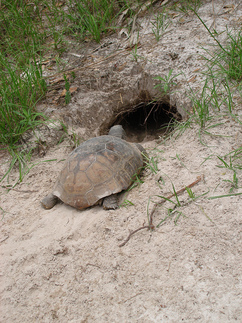 Funded through the Climate Adaptation Objective, the goal of this project was to examine the ability of gopher tortoises and their burrow commensals to retreat from sea level rise at Kennedy Space Center. Tortoises are especially vulnerable to sea level rise at KSC because a large percentage of the known population is found along the coastal dune system. This project identified two roadside corridors leading inland that could be used by gopher tortoises in the event of a managed retreat, but translocations may be needed to facilitate a managed retreat. The lack of movement observed through corridors may be due to the variety of barriers that could impact movement. In particular, railroad tracks are shown to significantly impact movement. Few commensal species were documented at KSC.
|
Above: Gopher tortoise at the
entrance of a burrow in Florida
12. Development of Regional Bank Erosion
Relationships for the Gulf Coastal Plain Hydrophysiographic Region – Johan Liebens, University of West
Florida
Funded through the Freshwater
Goal, the goal of this project was to provide
a tool for rapidly assessing and prioritizing streams for restoration. The
project sought to develop a predictive
method for a rapid assessment of erosion potential in an effort to focus
limited funding on the sites that are at high risk. Several methods have been
developed to predict streambank erosion but the most popular one is the BANCS
method. The BANCS method predicts streambank erosion with regression models for
various categories of banks, based on the near-bank stress of the stream flow
and the erosion potential of the stream bank. Because the BANCS method is an
empirical model, it has to be calibrated for every physiographic region. The
present study collected data at 75 sites in the Florida Panhandle and adjacent
areas of southern Alabama and Southwest Georgia over a two-year period to
calibrate the BANCS method for the coastal plain of the northern Gulf of
Mexico. Data were collected in accordance with the standard BANCS method but
additional ancillary information to enhance the model also was gathered. Project
personnel found the standard BANCS model is not a good predictor of stream bank
erosion in the study area and developed a more robust statistical approach
using a nonlinear model, data for additional hydrological and geomorphological
parameters, and assessment of the effectiveness of all possible subsets of
predictor variables. This approach resulted in a much better predictive model.
13. A Collaborative Approach for Implementing Plans to Restore
Vulnerable Species of Greatest Conservation Need - Terry Doonan, Laura Barrett and Claire Sunquist Blunden, Florida Fish and Wildlife Conservation Commission
Funded through the Monitoring
and Adaptation Goal, the goal of this project was
to aid in the development of Florida’s Imperiled Species Management
Plan as part of a new Imperiled Species Management System that started in 2010.
This project helped develop a progressive approach to Endangered and Threatened
species management in Florida, including development of Species Actions Plans
and the Imperiled Species Management Plan. The Plan, along with the supporting
Species Action Plans, addresses the needs of 57 species and will aid in
implementation of prioritized actions for state-listed and recently delisted species.
Above: Cover of the FWC's Imperiled Species Management Plan
14. Maximizing
the Value of Florida’s Priority Scientific Information through Data
Coordination and Quality Assurance – Erin Leone, Florida Fish and
Wildlife Conservation Commission
Funded through the Monitoring
and Adaptation Goal, the goal of this project was
to hire a Quantitative Data Manager (QDM) whose main focus was to work with
State Wildlife Grant recipients to collect project-level metadata upon
project completion, to develop data deliverable guidelines and to ensure
appropriate data management. This project supported a QDM who successfully
coordinated the collection of project data from SWG projects completed in
2012-2016.
|